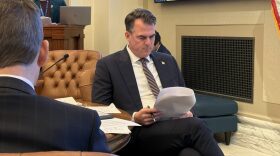Listener Daniel Humphrey heard Oklahoma City’s drag performances used to be famous nationwide and that celebrities like Frank Sinatra and Johnny Carson visited the city to see shows. So he asked How Curious: Was Oklahoma home to one of the country’s most renowned drag scenes?
Oklahoma City’s Northwest 39th Street has been a local LGBTQ hotspot since the 1980s.
Some residents fondly call the area “The Strip” or “The Gayborhood.” The district features a handful of gay bars and nightclubs, with regular drag shows and RuPaul’s Drag Race watch parties. It also hosts the city’s annual Pride festival.
“There’s gonna be everybody from every walk of life,” said Lauren Zuniga, president of the Oklahoma City Pride Alliance.
But 39th Street wasn’t always an LGBT gathering place.
“Known Spots”
Oklahoma City hosted traveling female impersonation shows as early as 1908, when a Lyric Theater performance by Lou Bates was advertised in the newspaper. Female impersonator Julian Eltinge performed at the Overholser Opera House about a decade later. Clubs like The Garden of Allah, later known as Louie’s 29 Club, staged impersonation shows, and The Jewel Box Revue traveling group also made regular stops in the city.
“They came sometimes for two to three weeks at a time. They would sell out clubs. And these were not gay clubs, they were just regular bars,” said Aaron Bachhofer, Associate Dean of the Social Sciences Division and Professor of History at Rose State College.
By the the 1940s and 50s, a number of downtown businesses catered to LGBTQ customers.
“There were known spots--areas where gay and lesbian folks could congregate,” Bachhofer said.
Places like Bishop’s Tap Room, across from the Skirvin Hotel on North Broadway, or along Grand Avenue (now Sheridan), spots like The Circus Room, Talk of the Town, The It’ll Do Club and The Mirror Lounge.
The Mayflower Lounge, in a dingy former office building on the northeast corner of Northwest 23rd Street and Classen, was Oklahoma City’s most popular gay bar in the late 1950s, Bachhofer said. According to former customers, The Mayflower’s leaky roof caused pieces of wallboard to fall from the ceiling into patrons’ drinks, so management tacked a military parachute on the ceiling.
Some claim Johnny Carson mentioned The Mayflower on The Tonight Show when it closed around 1964 after suffering a bad fire.
Oklahoma City’s first permanent “drag bar,” The Inferno, opened in 1958. Tony Sinclair, one of Oklahoma City’s best known female impersonators, performed there in the regular show “Les Girls Revue.” Sinclair imitated celebrities from Mae West to Diana Ross to Marilyn Monroe.
“All Of A Sudden, There’s 30 Cops Everywhere”
Not long ago, Oklahoma City’s LGBTQ clubs and their patrons faced the constant threat of being raided or arrested.
“You had to be careful when you came in and careful when you left,” said John Gibbons, co-owner of The Boom nightclub.
In 1983, a club called Angles on Northwest 39th Street filed a federal lawsuit against the City of Oklahoma City. It accused a handful of police officers of harassing customers and alleged officers participated in “a campaign of terror, intimidation, harassment and abuse.”
“I can remember being 22 years old with my boyfriend on the dance floor at Angles, and the doors open up and all of a sudden, there’s 30 cops everywhere,” Gibbons said.
Oklahoma City settled the lawsuit for $1, plus legal fees, and city police officers agreed to obey a permanent injunction to reduce police presence near the club.In a 1983 interview with The Gayly Oklahoman newspaper, Angles club owners said the settlement set a precedent for the entire gay community.
Did Frank Sinatra And Johnny Carson Fly In For OKC Drag Shows?
It’s difficult to prove whether the rumor Daniel Humphrey heard is true.
Frank Sinatra stayed at the Skirvin back when a number of downtown bars were LGBTQ-friendly. Bachhofer said Sinatra or Johnny Carson could have stopped into one of these spots while visiting Oklahoma City.
“Maybe they went to The Mayflower when they were here, or maybe they went to Bishop’s Tap Room,” Bachhofer said.
Lauren Zuniga isn’t aware of any celebrity appearances in the history of Oklahoma City’s drag scene, but, like Bachhofer, she says it’s possible people like Sinatra and Carson did come by.
“I haven’t heard about that, but that would not surprise me. Our drag shows are pretty top-notch,” Zuniga said.
How Curious is a production of KGOU Radio. It’s produced by Claire Donnelly and this episode was edited by Caroline Halter. David Graey composed the theme music. Special thansk this week to James Cooper.
Email your questions about Oklahoma to curious@kgou.org. Subscribe to the How Curious podcast on iTunes or your favorite podcast app.
As a community-supported news organization, KGOU relies on contributions from readers and listeners to fulfill its mission of public service to Oklahoma and beyond. Donate online, or by contacting our Membership department.








